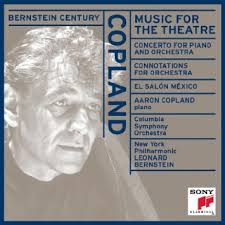 Aaron Copland and Leonard Bernstein are household names in the United States. Copland is perhaps the one American composer most U.S. citizens could identify if asked. Perhaps not as well known is the fact that Copland and Bernstein were friends for fifty years. It has been said that Bernstein, as a conductor, was “the ideal interpreter” of Copland’s music.
Aaron Copland and Leonard Bernstein are household names in the United States. Copland is perhaps the one American composer most U.S. citizens could identify if asked. Perhaps not as well known is the fact that Copland and Bernstein were friends for fifty years. It has been said that Bernstein, as a conductor, was “the ideal interpreter” of Copland’s music.
This CD, titled after the first cut, Music for the Theatre, is a collection of four works by Copland conducted by Bernstein on various occasions. Copland composed Music for the Theatre, a suite in five parts, in 1925. He was himself 25 at the time. The suite is strongly evocative of the Broadway of the day, and of American musical theatre in general. The second part, “Dance,” in particular, is reminiscent of the big bright dance numbers in musicals such as The Music Man and West Side Story. “Dance” opens with a melody begun by a single oboe and then transfers to a cornet. The solitary-but-cheerful sound is signature Copland.
The next piece is Concerto for Piano and Orchestra, with the piano being played for this recording by Copland himself. Written in 1926, the liner notes accompanying the CD call this “Copland’s great vehicle as a solo pianist. [I]n this recording, he brings just the right degree of jaunty, jazzy pizzaz to a playful and invigorating piece.” The first movement showcases Copland’s virtuosity on the piano. His playing begins as a trickling of notes, emerging first singly and then clanging gently together in pairs, to be joined by the swell of the orchestra. The second movement is angular, discordant and modern at first, but with a bright, positive energy very different from the angry confusion conveyed by other modernist composers. The angular sound here moves easily into the jazz of improv, springy rhythms and baffled trumpets blaring. At times it mounts to a louder, driving sound, then slips back into moments of bouncy syncopation. As a whole, the concerto is a masterful blend of American jazz and classical orchestral sound.
Connotations for Orchestra has been called a “neglected masterpiece.” It was commissioned in 1962 to open the Philharmonic Hall and the Lincoln Center for the Performing Arts in New York City. Like the second movement of the Concerto for Piano and Orchestra, this is a loud, angular work, bold and arrogant, using sharp percussion in a martial mode to convey a feeling of “bigness.” It’s mature Copland, and the “bigness” here had already become one of Copland’s most notable traits as a composer. It’s also a significant sign of Copland’s achievement that his unique sort of “bigness” or “grandness” is recognized the world over as “American.”
My favorite work on this album is the last, El Salón México. Copland wrote it in Mexico City, while he lived there between 1933 and 1936. It was first performed by the Orquesta Sinfonica de México, directed by Carlos Chávez. Like most of Copland’s work, El Salón is bright, grand and hopeful, yet threaded through it are strains of lilting, minor melody, echoes of Mexican folk songs. When a violin and oboe take up the melody at one point, it’s particularly poignant. Also punctuating this piece are moments of brilliant mariachi sound, which the orchestra’s massed strings emulate and yet transmute into something a little more majestic. Then the timpani crashes through in a way that Copland intended to represent earthquakes. Altogether, El Sálon brings to mind the fever and energy of Mexico in the 1930s, with the brilliant drenched colors of Rivera’s murals as a backdrop.
This CD is one of a series called The Bernstein Century, which is a collection of recordings of music that Leonard Bernstein conducted in the course of his career. The series includes composers such as Bach, Barber, Bizet, Gershwin, Holst, Mahler and Respighi, as well as Copland. All of the pieces on this recording are remasterings of earlier recordings of Leonard Bernstein conducting. Music for the Theatre was recorded on December 15, 1958, at the St. George Hotel, Brooklyn, New York. Concerto for Piano and Orchestra was recorded on January 13, 1964, at Philharmonic Hall, Lincoln Center, New York City. Connotations for Orchestra was recorded on September 23, 1962, at Philharmonic Hall. And El Salón México was recorded on March 22-23, 1951. This is the first time El Salón México has been released on CD.
All the recordings here were performed by either the Columbia Symphony Orchestra or the New York Philharmonic, although the liner notes do not specify which recording was performed by which orchestra. The liner notes are rather brief on the whole, although the booklet itself is quite thick, with the notes being offered in several languages.
Aaron Copland
